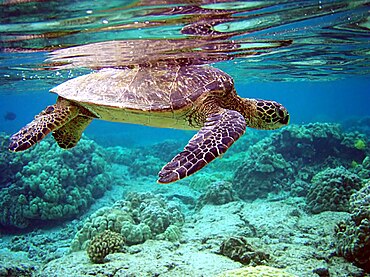
Sea turtle migration is the long-distance movements of sea turtles (superfamily Chelonioidea) notably the long-distance movement of adults to their breeding beaches, but also the offshore migration of hatchings. Sea turtle hatchings emerge from underground nests and crawl across the beach towards the sea. They then maintain an offshore heading until they reach the open sea.[1] The feeding and nesting sites of adult sea turtles are often distantly separated meaning some must migrate hundreds or even thousands of kilometres.[2]
Several main patterns of adult migration have been identified.[3] Some such as the green sea turtle shuttle between nesting sites and coastal foraging areas. The loggerhead sea turtle uses a series of foraging sites. Others such as the leatherback sea turtle and olive ridley sea turtle do not show fidelity to any specific coastal foraging site. Instead, they forage in the open sea in complex movements apparently not towards any goal. Although the foraging movements of leatherbacks seem to be determined to a large part by passive drift with the currents, they are still able to return to specific sites to breed. The ability of adult sea turtles to travel to precise targets has led many to wonder about the navigational mechanisms. Some have suggested that juvenile and adult turtles might use the Earth's magnetic field to determine their position. There is evidence for this ability in juvenile green sea turtles.[4]
- ^ Cite error: The named reference
multiplewas invoked but never defined (see the help page). - ^ Russell, A.P.; Aaron M. Bauer; Megan K. Johnson (2005). "Migration in amphibians and reptiles: An overview of patterns and orientation mechanisms in relation to life history strategy". In Elewa, Ashraf M.T. (ed.). Migration of organisms: climate geography, ecology. Berlin: Springer-Verlag. pp. 151–184.
- ^ Sale, Alessandro; Luschi, Paolo (2009). "Navigational challenges in the oceanic migrations of leatherback sea turtles". Proceedings of the Royal Society of London B: Biological Sciences. 276 (1674): 3737–3745. doi:10.1098/rspb.2009.0965. PMC 2817277. PMID 19625321.
- ^ Lohmann, Kenneth J.; Lohmann, Catherine M. F.; Ehrhart, Llewellyn M.; Bagley, Dean A.; Swing, Timothy (2004). "Geomagnetic map used in sea-turtle navigation". Nature. 428 (6986): 909–910. doi:10.1038/428909a. PMID 15118716. S2CID 4329507.
© MMXXIII Rich X Search. We shall prevail. All rights reserved. Rich X Search
